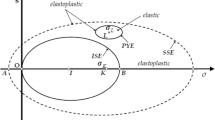Conclusions
-
1.
The formation of a clay antiseepage wall is accompanied by the settlement of its upper boundary as a result of the lateral outflow of filtrate through the edge of the curtain.
-
2.
The properties of the filler and soil surrounding the body of the antiseepage wall have a significant effect on the settlement.
-
3.
To fill the settlement cavity that is formed, it is necessary to specify an additional amount of clayey-soil of fluid consistency as determined from the equation Qadd= 2lSL, where L is the length of the curtain in m.
Similar content being viewed by others
Literature cited
V. N. Zhilenkov, Water-Retaining Properties of Earth Cores and Curtains for High Dams [in Russian], Énergiya, Moscow (1968).
I. P. Chernyi, “Technology of the construction of thin antiseepage walls,” Proceedings of the Seventh All-Union Conference on Soil Stabilization and Compaction [in Russian], Énergiya, Leningrad (1971).
A. N. Meshcheryakov and V. B. Kheifets, Antiseepage and Bearing Walls in the Ground [in Russian], Énergiya, Moscow (1969).
Additional information
Translated from Gidrotekhnicheskoe Stroitel'stvo, No. 1, pp. 17–19, January, 1980.
Rights and permissions
About this article
Cite this article
Nedriga, V.P., Gladilin, A.M. & Chernyi, I.P. Computing the settlement of thin antiseepage walls formed from clayey soils. Hydrotechnical Construction 14, 29–32 (1980). https://doi.org/10.1007/BF02307955
Issue Date:
DOI: https://doi.org/10.1007/BF02307955



